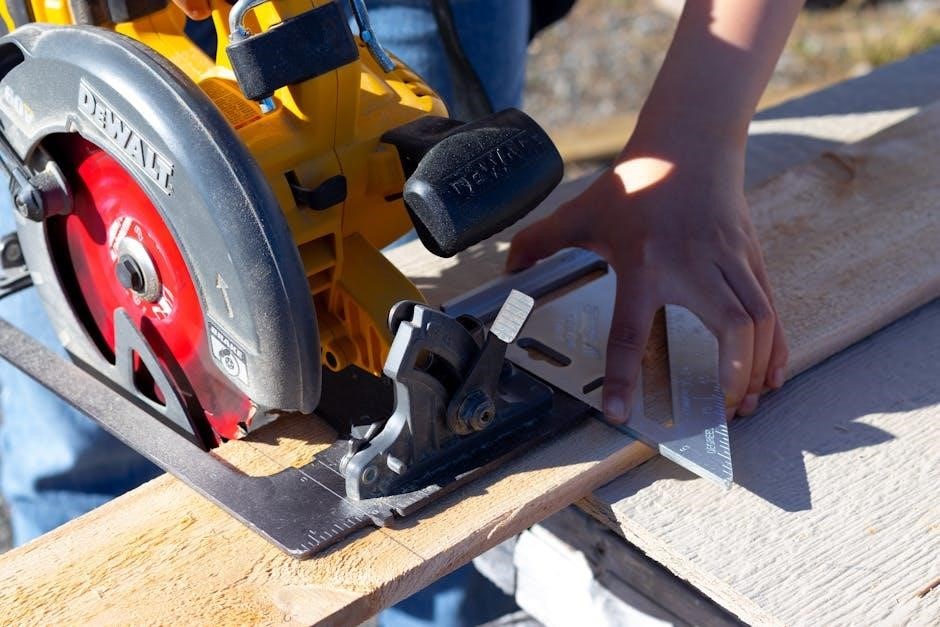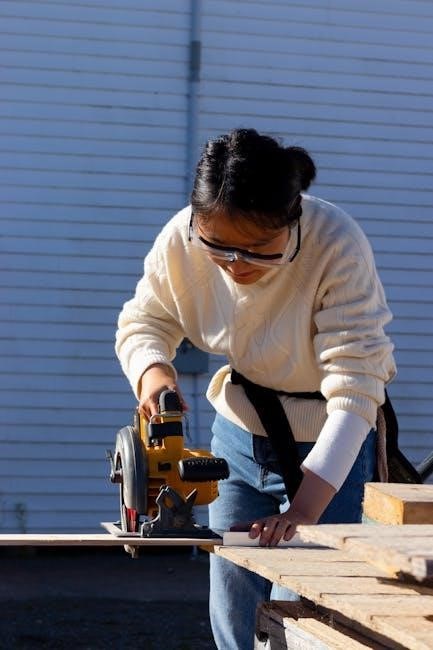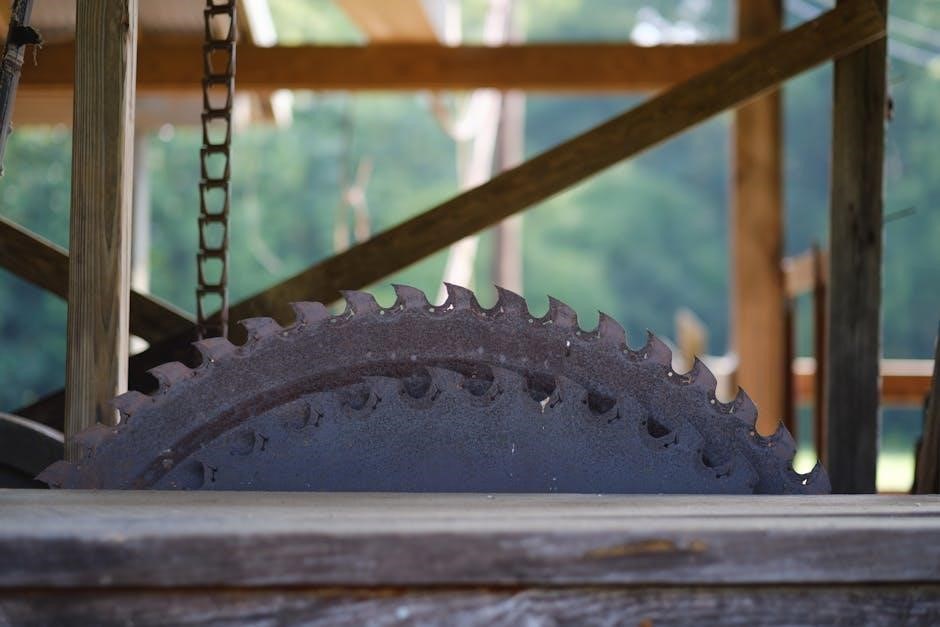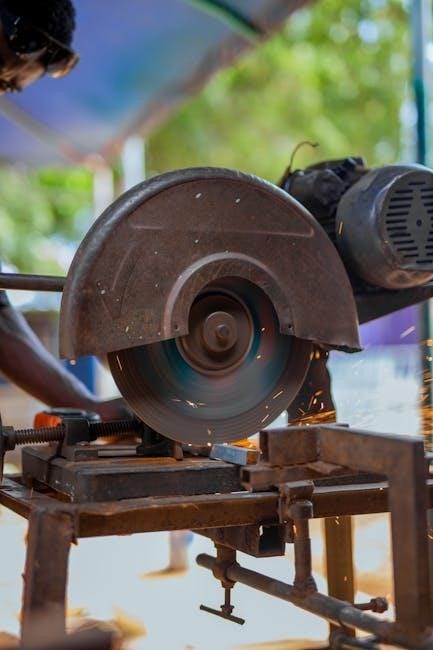Circular saw blade teeth are crucial for cutting performance, determining efficiency and finish quality. Understanding tooth configuration, materials, and maintenance ensures optimal results in various cutting applications.
1.1 Understanding the Basics of Circular Saw Blades
Circular saw blades are circular tools with teeth on their edge, designed for cutting materials like wood, metal, and plastic. The blade’s diameter, tooth count, and material type determine its performance. Teeth configuration, such as rip or crosscut, affects cutting efficiency and finish quality. Proper blade selection and maintenance are essential for optimal cutting results and tool longevity.
1.2 Importance of Teeth Configuration in Cutting
Teeth configuration significantly impacts cutting efficiency and finish quality. Different tooth patterns, such as rip or crosscut, are designed for specific tasks. Rip teeth, with fewer, larger teeth, excel at cutting with the wood grain, while crosscut teeth, finer and more numerous, provide smoother cuts against the grain. Proper tooth selection ensures faster cuts and minimizes material waste and damage.

Types of Circular Saw Blade Teeth Configurations
Circular saw blades feature various tooth configurations, including rip cut, crosscut, and specialized designs. Each type is tailored for specific cutting tasks, enhancing performance and precision.
2.1 Rip Cut Teeth
Rip cut teeth are designed for cutting wood along the grain, typically with 30-40 teeth. Their aggressive, angled design ensures fast, rough cuts, ideal for framing and ripping lumber. The wide gullets between teeth allow for efficient chip removal, making them suitable for heavy-duty applications where speed is prioritized over precision. They are less precise but faster than crosscut options.
2.2 Crosscut Teeth
Crosscut teeth are optimized for cutting wood across the grain, featuring 40-80 teeth. Their alternating bevel angles produce smooth, precise cuts, reducing splintering. Narrow gullets and a higher tooth count minimize tearout, making them ideal for finish work, such as trimming and joinery. They prioritize accuracy and clean results over speed, suitable for applications requiring high-quality finishes in woodworking projects.

Materials and Coatings for Circular Saw Blades
Circular saw blades are made from high-speed steel (HSS) for durability and carbide-tipped for hardness. Coatings like titanium nitride enhance performance and extend lifespan.

3.1 High-Speed Steel (HSS) Blades
High-Speed Steel (HSS) blades are durable and heat-resistant, making them ideal for cutting wood, metal, and plastics. They offer excellent versatility and cost-effectiveness for general-purpose applications, ensuring reliable performance across various materials.
3.2 Carbide-Tipped Blades
Carbide-tipped blades feature extremely hard, wear-resistant teeth, enhancing durability and cutting efficiency. They excel in demanding applications, such as cutting hardwoods, metals, and composite materials. The carbide tips significantly extend blade life, making them a cost-effective choice for professionals seeking high performance and longevity in heavy-duty tasks.
3.4 Coatings for Enhanced Performance
Coatings like titanium nitride (TiN) and diamond-like carbon (DLC) enhance blade performance by reducing friction and preventing overheating. These coatings protect the teeth from wear and corrosion, extending blade life. They are particularly effective in cutting hard materials, improving durability and maintaining sharpness. Coatings are applied to carbide-tipped blades to ensure smoother cuts and minimize wear, optimizing overall cutting efficiency.

Understanding Tooth Count and Its Impact
Tooth count directly affects cutting speed and finish. Fewer teeth cut faster but leave a rougher edge, while more teeth deliver smoother results at a slower pace.
4.1 The Relationship Between Tooth Count and Cutting Speed
A lower tooth count increases cutting speed due to larger gullets, removing more material per pass. Higher tooth count reduces speed but enhances precision, minimizing tearout for smoother finishes. Balancing teeth and gullet size optimizes performance for specific tasks, ensuring efficient and accurate cuts across various materials and applications.
4.2 How Tooth Count Affects the Quality of the Cut
A higher tooth count typically results in a smoother cut with less tearout, making it ideal for materials like plywood. Fewer teeth can lead to rougher edges but faster cuts. The right balance ensures clean, precise results, minimizing material damage and improving overall finish quality for various applications and materials.

Anatomy of a Circular Saw Blade
A circular saw blade consists of a steel body, teeth, arbor, and bore. The blade body provides structural integrity, while the arbor secures it to the saw.
5.1 The Blade Body and Its Construction
The blade body is the main structural component, typically made of high-quality steel for durability. Its design minimizes vibration, ensuring stable cuts. The teeth are securely brazed or welded to the body for strength. The body’s thickness and construction materials significantly impact cutting performance, heat resistance, and longevity, making it essential for optimal functionality across various materials and applications.
5.2 The Role of the Arbor and Bore
The arbor is the mounting system securing the blade to the saw, ensuring precise alignment. The bore is the central hole in the blade, matching the arbor’s size. Proper fitting prevents vibration and ensures safe operation. Accurate alignment between the arbor and bore is critical for optimal performance, minimizing wear and ensuring consistent cutting results across various materials and applications.
5.3 Kerf and Its Significance
Kerf refers to the width of the cut made by the saw blade, determined by the blade’s thickness. A thinner kerf removes less material, reducing waste and saving time. Proper kerf management enhances cutting efficiency, especially in materials like wood or metal, ensuring precise cuts and minimizing unnecessary material loss, which is vital for both productivity and cost-effectiveness in various projects.

Maintenance and Care for Circular Saw Blades
Regular sharpening and cleaning extend blade life. Store blades dry to prevent rust. Proper care ensures optimal performance and longevity in cutting applications.
6.1 Sharpening and Reconditioning Blades
Sharpening circular saw blades requires precision to maintain tooth geometry. Use specialized tools or professional services to restore sharpness. Reconditioning involves correcting warps and replacing worn teeth, ensuring consistent cuts and extending blade lifespan. Regular maintenance prevents dullness and enhances performance, making it a cost-effective solution for professionals and DIYers alike. Proper techniques are essential for optimal results.
6.2 Cleaning and Storage Best Practices
Clean blades regularly with solvents or oil to remove debris and prevent rust. Dry thoroughly after cleaning and apply a rust-inhibiting coating. Store blades in a dry, cool place, away from direct sunlight. Avoid stacking blades to prevent damage. Proper storage and cleaning extend blade lifespan, ensuring optimal performance and reducing maintenance costs over time.
Safety Guidelines for Handling Circular Saw Blades
Always wear protective gear, including gloves and safety glasses. Handle blades with care to avoid cuts. Ensure proper installation and alignment before use to prevent accidents and ensure stability.
7.1 Precautions for Safe Blade Installation
Always ensure the blade is installed with teeth pointing in the correct direction as marked on the guard. Secure the blade tightly using the provided wrench, and double-check alignment with the arbor; Never install a damaged or dull blade, as it may cause vibrations or kickback. Wear gloves and safety glasses during installation to prevent injuries from sharp edges or accidental starts.
7.2 Operating Safety Tips
Always wear safety glasses and a dust mask when operating a circular saw. Keep loose clothing tied back and avoid wearing jewelry that could catch in the blade. Maintain a firm grip on the saw with both hands, ensuring proper control. Never cut freehand; use a stable work surface and push the saw steadily through the material. Keep children and bystanders at a safe distance from the work area. Avoid overreaching or twisting the saw, as this can cause loss of control. Ensure the blade is appropriate for the material being cut to prevent kickback or binding. Regularly inspect the blade for damage or wear and replace it when necessary. Always unplug the saw when changing blades or performing maintenance. Proper ventilation is essential when cutting materials that produce harmful fumes or dust. Familiarize yourself with the saw’s features and follow the manufacturer’s guidelines for optimal safety and performance. Make sure the work area is well-lit to maintain clear visibility of the cutting path. Keep emergency equipment, such as a first aid kit, nearby in case of accidents. Never operate the saw near flammable materials or in areas where sparks could ignite fires. Be mindful of the saw’s power cord to prevent tripping hazards. Always follow proper shutdown procedures, allowing the blade to come to a complete stop before setting the saw down. Stay alert and avoid distractions while operating the saw, as even a momentary lapse in concentration can lead to accidents. By adhering to these safety tips, you can minimize risks and ensure a safe cutting experience.

Applications and Use Cases
Circular saw blades are essential for woodworking, construction, and metal cutting. Specialized blades handle materials like wood, metal, and masonry, ensuring precise cuts in various applications.
8.1 Ripping vs. Crosscutting: Choosing the Right Blade
Ripping involves cutting wood along its grain, requiring blades with fewer, larger teeth for speed. Crosscutting cuts across the grain, needing blades with more teeth for smooth finishes. Selecting the right blade ensures efficiency and quality in both tasks, with specialized teeth designs optimizing performance for each application.
8.2 Specialized Blades for Different Materials
Different materials demand specific blade types. For metals, carbide-tipped blades with fewer teeth are ideal. Masonry blades feature abrasive edges for concrete. Laminate and plywood require high-tooth count blades for clean cuts. Specialized coatings, like diamond-tipped for ceramics, enhance durability. Choosing the right blade ensures precise cutting and extends tool life across various materials and applications.

Troubleshooting Common Issues
Circular saw blades may face dullness, wear, or vibration. Diagnose issues by inspecting teeth for damage and ensuring proper blade alignment. Address problems promptly for optimal performance.
9.1 Diagnosing Blade Dullness and Wear
Dullness and wear on circular saw blades can be identified by poor cutting performance, increased vibration, or uneven finishes. Inspect the teeth for chipping, worn edges, or excessive dullness. Clean the blade to remove debris, as residue can mask wear; If issues persist, consider sharpening or replacing the blade to restore cutting efficiency and prevent further damage.
9.2 Resolving Vibration and Misalignment Problems
Vibration and misalignment in circular saw blades can cause inaccurate cuts and damage equipment. Check blade balance and ensure proper alignment with the arbor. Secure the blade tightly, and inspect for damage or wear. Misalignment may require adjusting the saw’s arbor or replacing worn parts. Regular maintenance and proper installation help prevent these issues, ensuring smooth operation and precise cuts.
Understanding circular saw blade teeth is essential for optimal performance and safety. Proper selection, maintenance, and care ensure precise cuts and prolong blade life, enhancing overall efficiency.
10.1 Summary of Key Points
Proper tooth configuration, blade materials, and maintenance are vital for optimal performance. Understanding tooth count, kerf, and blade anatomy ensures precise cuts. Safety guidelines and correct blade installation prevent accidents. Regular sharpening and storage prolong blade life. Selecting the right blade for specific tasks enhances efficiency and quality, making it essential for achieving professional-grade results in woodworking and construction projects.
10.2 Final Tips for Optimal Blade Performance
To maximize circular saw blade performance, always store blades dry and clean. Sharpen or replace dull teeth promptly and use the correct blade for your material. Avoid overheating by maintaining proper cutting speeds. Inspect blades regularly for damage or wear. Follow manufacturer guidelines for installation and operation. Proper care ensures prolonged blade life and consistent, high-quality cuts across various projects.
